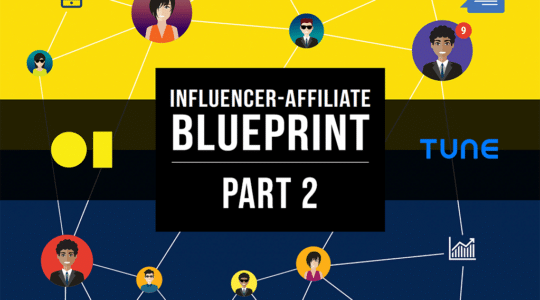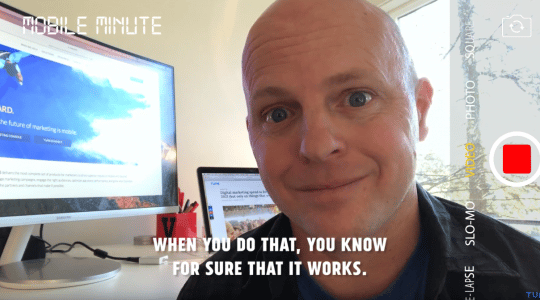
The question of how to start a new affiliate program often arises as more and more businesses choose to add performance marketing to their overall digital strategy. This article aims to provide businesses that are new to affiliate marketing with a useful introduction, and businesses that are experienced in the performance marketing space with a valuable refresher.
Performance marketing is a measurable method of advertising that tracks clicks and conversions, giving clearer insight into how marketing dollars are spent and where users are coming from. Businesses pay publishers a commission fee for each lead or sale that is driven from the publisher to the advertiser’s website. This relationship results in more traffic to the business’s website, and ultimately more revenue. Performance marketing provides a win-win solution for all parties.
When exploring performance marketing, businesses with marketing spend are faced with two choices: sign up with an existing ad network, or buy a tracking software to run their own affiliate program. To understand the difference between these options and make the best choice for your business, we’ve compiled pros and cons for both sides.
Option 1: Buy a Performance Marketing Tracking Platform
A tracking platform allows a business to effectively manage their internal marketing campaigns, publisher relationships, invoices, and much more — all under one dashboard. Real-time data analytics and reporting enables strategic management of advertising spend and informed decision making. Unlike ad networks, most tracking platforms are unbiased. There are no offer marketplaces provided, and publisher relationships are managed directly by the user. In addition, most tracking platforms are self-service and require day-to-day management, and with that, give direct insight into publisher relationships.
Option 2: Sign Up With an Ad Network
An ad network provides advertisers with a marketplace of publishers who are willing to promote the advertiser’s goods or services on their own websites and marketing channels. Think of an ad network as the middle-man that connects advertisers with publishers. Advertisers are able to easily reach a large audience, while publishers are able to find affiliate programs that are suitable for their traffic types through an ad network. Ad networks oversee these relationships and take on the role of management. The more costly option, joining an ad network grants advertisers a hands-off way of promoting their product or service through a wide variety of publisher channels.
Many words are interchangeable or loosely defined in the performance marketing and affiliate program space. Before diving into the pros and cons of joining an ad network or purchasing a tracking platform, we’ll first define key industry terms:
- Affiliate Program: A program offered by advertisers that gives affiliates the opportunity for compensation in exchange for promoting their product or service. Affiliates are paid by the advertiser when a predetermined conversion point occurs (i.e. user makes a purchase, fills out a form, signs up for something, etc.).
- Performance Marketing Tracking Platform (also known as a tracking solution or tracking software): Software that empowers businesses to track and manage their publisher relations and marketing efforts directly under one dashboard.
- Ad Network (also known as a network or affiliate network): A company that acts as the relationship middle-man between advertisers and publishers, so advertisers are free to focus on their products and services, and publishers are free to focus on publishing and promoting offers.
- Advertiser (also known as merchant, brand or marketer): An owner of a product or service looking to pay publishers to drive targeted traffic to their brand, with the end goal of increasing revenue.
- Publisher (also known as affiliate or partner): A marketer who promotes advertiser products and services by driving traffic to their websites through paid or non-paid channels. They generate revenue for the advertiser and get paid each time a predetermined trackable user action occurs.
- Traffic (also known as users or visitors): Actions that are measurable against an ad. Impressions (ad view), clicks (ad click), and conversions (ad engagement) are the most common examples.
There are a number of factors that should be considered when deciding whether to buy a tracking platform or sign up with a network. Some of the most important considerations include cost, time, and current publisher relationships in your affiliate program.
Now that you’re familiar with industry terms, we will highlight the pros and cons associated with different factors in order for you to make the best decision for your business.
Upfront Cost
When considering the role that budget plays in both scenarios, it is important to be aware of the difference in cost associated with networks and tracking platforms. Networks commonly require a fee upon sign-up.
In comparison, starting with a tracking platform commonly requires a budget for advertising the affiliate program in order to gain publishers. The good news is, tracking platforms do not require a fee and in most cases offer a free trial period.
| Scenario | Pros | Cons |
| Joining a network | • Minimal advertising spend | • Network fees are often required upon sign-up |
| Buying a platform | • No upfront cost required upon sign-up
• Free trial period offered by most tracking platforms |
• Potentially more money spent on advertising |
Ongoing Cost
Signing up for a tracking platform and joining a network present different ongoing costs. When signing up for a tracking platform, businesses need to consider the cost of managing the program. Depending on the specifics of the program, the range of salary costs can span one individual working part time, to a small or large team working full time to manage an affiliate program. Although management costs are greater, all other costs are minimal. Most tracking platforms bill on a subscription basis and charge a much lower, consistent amount.
On the contrary, when joining a network, the cost of management is lower but all other ongoing costs are significantly higher. Networks commonly charge based on a percentage of affiliate commission or a percentage of sales generated through your affiliate program. Although percentages often vary, the network fee alone is typically around 30% of user purchases (this does not include affiliate payout). Besides network fees, additional costs include affiliate commission fees, monthly minimum fees, and service costs.
| Scenario | Pros | Cons |
| Joining a network | • Hiring an affiliate manager is not always necessary | • Networks commonly charge a commission
• Additional costs |
| Buying a platform | • Low, predictable costs | • Affiliate manager is often required |
Time
For businesses starting in performance marketing, managing affiliates and developing the product can quickly take up the majority of your time. However, how your time is spent differs between purchasing a tracking platform and joining an ad network. When joining an ad network, less time is spent managing affiliates, but the tradeoff is paying the ad network to do that for you and having less visibility over the data. On the other hand, a tracking platform requires more time investment, however gives you ownership over making data-backed decisions and optimizations. Below is how we think about the time tradeoffs for joining an ad network vs. building your own.
| Scenario | Pros | Cons |
| Joining a network | • Less time dedicated to implementation of tracking links, offers, and other day-to-day tasks
• Requires minimal management and overhead |
• Little visibility into data
• Little ability to optimize • No communication with affiliates or ability to build relationships |
| Buying a platform | • Access to robust tracking, reporting and other features
• Direct communication with affiliates • Complete control over data • Confidence to make data-backed decisions |
• Requires day-to-day management of the affiliate program
• Upfront time investment for implementation |
Publisher Relationships
One of the greatest differences between signing up for a tracking platform and joining an ad network is the type of relationships a business is able to form with publishers. Choosing to sign up with a tracking platform allows a business to maintain an open line of communication with publishers, which brings about a number of benefits. Direct communication enables a business to establish trust, which makes publishers more inclined to prioritize their offers. Other benefits include the ability to identify the best performing publishers and incentivize them with rewards, and assurance that publishers are aligned with business objectives and stay on brand via data transparency.
When joining a network, communication with publishers is minimal or — in most cases — nonexistent. Businesses have little visibility into the publishers who are promoting their product or service, leading to a higher chances of fraudulent activity.
| Scenario | Pros | Cons |
| Joining a network | • Minimal time required managing publisher relationships | • No guarantee publishers stay on brand
• No way to incentivize publishers • Higher chance of spamming and fraud |
| Buying a platform | • Direct communication with publishers
• Ability to incentivize publishers • Knowing that publishers stay on brand • Ability to quickly solve issues due to strong publisher relationship |
• Ongoing time investment into building and managing publisher relationships |
A Final Word on Affiliate Programs
As we have shown, there are both advantages and disadvantages to buying a tracking platform and signing up with an ad network. For businesses seeking a quick, hands-off way of launching a short-term affiliate program, signing up with a network is the best option for you. Although, it is important to be aware of the tradeoffs: Joining a network is far more costly in the long run, and can significantly limit your ability to scale.
For businesses interested in sustainability and scalability, buying a performance marketing tracking solution is the right decision for you. Although there are advertising costs and affiliate management overhead associated with this option, the ongoing costs are lower and more predictable, which sets businesses up for long-term growth.
To help jumpstart your affiliate program, here are tips on how to gain affiliates. If you’re ready to take your program to the big leagues, download our free guide.
Some businesses may find themselves caught somewhere in the middle. If that sounds like you, feel free to reach out to [email protected] to learn how to get started.
Author
Becky is the Senior Content Marketing Manager at TUNE. Before TUNE, she handled content strategy and marketing communications at several tech startups in the Bay Area. Becky received her bachelor's degree in English from Wake Forest University. After a decade in San Francisco and Seattle, she has returned home to Charleston, SC, where you can find her strolling through Hampton Park with her pup and enjoying the simple things in life.




Leave a Reply
You must be logged in to post a comment.